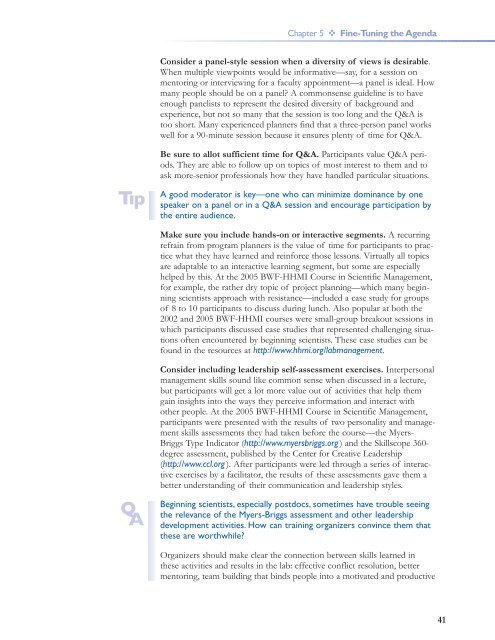Training Scientists to Make the Right Moves - Howard Hughes ...
Training Scientists to Make the Right Moves - Howard Hughes ...
Training Scientists to Make the Right Moves - Howard Hughes ...
You also want an ePaper? Increase the reach of your titles
YUMPU automatically turns print PDFs into web optimized ePapers that Google loves.
QA<br />
Chapter 5 Fine-Tuning <strong>the</strong> Agenda<br />
At a Glance<br />
Consider a panel-style session when a diversity of views is desirable.<br />
When multiple viewpoints would be informative—say, for a session on<br />
men<strong>to</strong>ring or interviewing for a faculty appointment—a panel is ideal. How<br />
many people should be on a panel? A commonsense guideline is <strong>to</strong> have<br />
enough panelists <strong>to</strong> represent <strong>the</strong> desired diversity of background and<br />
experience, but not so many that <strong>the</strong> session is <strong>to</strong>o long and <strong>the</strong> Q&A is<br />
<strong>to</strong>o short. Many experienced planners find that a three-person panel works<br />
well for a 90-minute session because it ensures plenty of time for Q&A.<br />
Chapter One<br />
At a Glance<br />
“”<br />
QA<br />
At a Glance<br />
Be sure <strong>to</strong> allot sufficient time for Q&A. Participants value Q&A periods.<br />
They are able <strong>to</strong> follow up on <strong>to</strong>pics of most interest <strong>to</strong> <strong>the</strong>m and <strong>to</strong><br />
ask more-senior professionals how <strong>the</strong>y have handled particular situations.<br />
A good modera<strong>to</strong>r is key—one who can minimize dominance by one<br />
speaker on a panel or in a Q&A session and encourage participation by<br />
<strong>the</strong> entire audience.<br />
<strong>Make</strong> sure you include hands-on or interactive segments. A recurring<br />
refrain from program planners is <strong>the</strong> value of time for participants <strong>to</strong> practice<br />
what <strong>the</strong>y have learned and reinforce those lessons. Virtually all <strong>to</strong>pics<br />
are adaptable <strong>to</strong> an interactive learning segment, but some are especially<br />
helped by this. At <strong>the</strong> 2005 BWF-HHMI Course in Scientific Management,<br />
for example, <strong>the</strong> ra<strong>the</strong>r dry <strong>to</strong>pic of project planning—which many beginning<br />
scientists approach with resistance—included a case study for groups<br />
of 8 <strong>to</strong> 10 participants <strong>to</strong> discuss during lunch. Also popular at both <strong>the</strong><br />
2002 and 2005 BWF-HHMI courses were small-group breakout sessions in<br />
which participants discussed case studies that represented challenging situations<br />
often encountered by beginning scientists. These case studies can be<br />
found in <strong>the</strong> resources at http://www.hhmi.org/labmanagement.<br />
Consider including leadership self-assessment exercises. Interpersonal<br />
management skills sound like common sense when discussed in a lecture,<br />
but participants will get a lot more value out of activities that help <strong>the</strong>m<br />
gain insights in<strong>to</strong> <strong>the</strong> ways <strong>the</strong>y perceive information and interact with<br />
o<strong>the</strong>r people. At <strong>the</strong> 2005 BWF-HHMI Course in Scientific Management,<br />
participants were presented with <strong>the</strong> results of two personality and management<br />
skills assessments <strong>the</strong>y had taken before <strong>the</strong> course—<strong>the</strong> Myers-<br />
Briggs Type Indica<strong>to</strong>r (http://www.myersbriggs.org ) and <strong>the</strong> Skillscope 360-<br />
degree assessment, published by <strong>the</strong> Center for Creative Leadership<br />
(http://www.ccl.org ). After participants were led through a series of interactive<br />
exercises by a facilita<strong>to</strong>r, <strong>the</strong> results of <strong>the</strong>se assessments gave <strong>the</strong>m a<br />
better understanding of <strong>the</strong>ir communication and leadership styles.<br />
Chapter One<br />
Beginning scientists, especially postdocs, sometimes have trouble seeing<br />
<strong>the</strong> relevance of <strong>the</strong> Myers-Briggs assessment and o<strong>the</strong>r leadership<br />
development activities. How can training organizers convince <strong>the</strong>m that<br />
<strong>the</strong>se are worthwhile?<br />
Organizers should make clear <strong>the</strong> connection between skills learned in<br />
<strong>the</strong>se activities and results in <strong>the</strong> lab: effective conflict resolution, better<br />
men<strong>to</strong>ring, team building that binds people in<strong>to</strong> a motivated and productive<br />
41
















